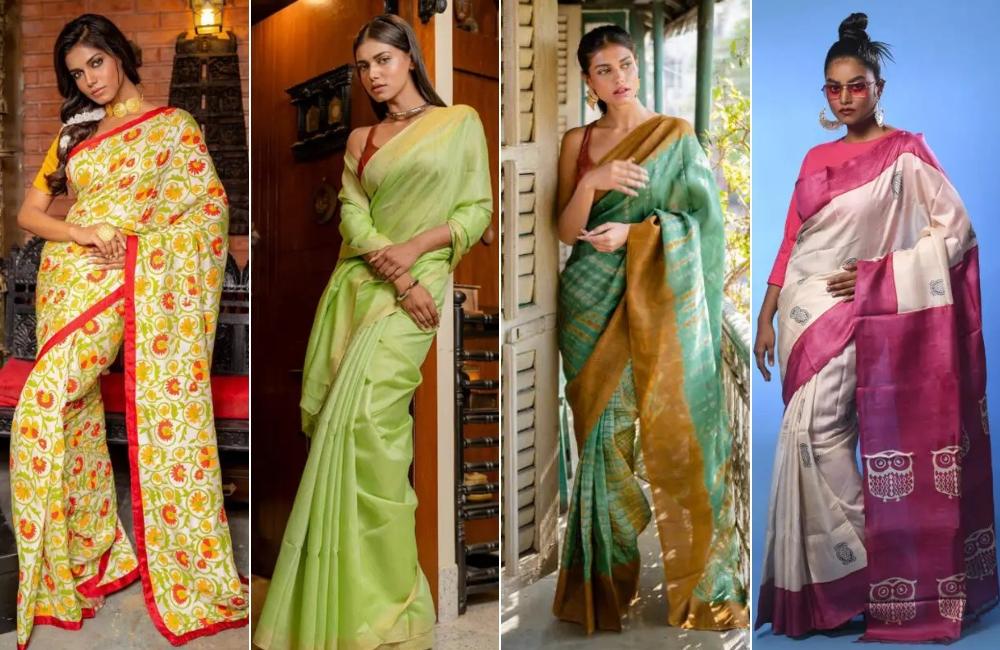The moment you hear about silk sarees, the visuals create a spark in your mind of smooth and shiny fabrics with a rich appeal. But honestly, silk sarees have more to them than those momentary visuals.
The making of beautifully created printed silk sarees you buy online is an equally enduring process. Understanding the nuances of silk saree making, different fabrics, and yarns is truly an enriching experience.
So, here is unveiling the story of silk sarees and a detailed guide to help you buy silk sarees online without falling prey to fake fabrics and yarns.
Classification of Silk Sarees Based on Materials
Silk yarns are produced from different species of moths. But the ones created from mulberry worms represent the finest grade of silk. When untreated, the yarns appear sticky and coated with chemicals. Before weaving those yarns into desirable fabrics, they are treated with chemicals. Depending on the base material or specifically the moth, the S, and Z-weave are commonly found in the Indian silk variants. Take a look at the types of silk sarees that are usually available with various patterns and prints:
Mulberry silk
As the name denotes, the mulberry silk variant is obtained from B, the Mori moths that thrive on the mulberry tree leaves. It takes a lot of effort and well-appointed sericulture to induce softness in these silk sarees. Truly speaking, it is one of the broader and top-grade variants of silk sarees and also the most expensive. The raw material is often used in weaving those opulent Murshidabad silk sarees or the high-quality Kanchipuram and Banarasi silk sarees that are cherished by saree enthusiasts across the globe. If you are searching for Bengal silk sarees in Kolkata that have captured hearts for years, Murshidabad silk should find a mention here.
While the history of mulberry silk can be traced back to Indus Valley Civilization, it has grown into other countries like India and China, the former being the second-largest manufacturer today.
Raw Silk
Raw silk is another variant weaved from untreated yarns containing sericin. In its natural form, the yarns appear coarse and uneven, giving your raw silk saree a similar texture. But one of the mesmerising characteristics of raw silk sarees is their exquisite lustre. Ever wondered about those behind the scene activities during the making of raw silk sarees when visiting the best saree shops in Kolkata? Experience deeper delight with the timeless elegance of raw silk sarees.
Tussar Silk
The wild silkworms that feed on oak leaves produce wild silk sarees, lending a rough and uneven texture to the sarees. That is the kind of texture you will usually find in tussar silk sarees. In India, the silk saree variants primarily come from the Indian tussar silkworm. Explore the rich diversity of Indian silkworms and the art of creating silk sarees through the irregular thread-cutting method. Tussar is one of the popular forms of wild silks available in India. Discover captivating tussar silk collections at Dora By Phoenix and get ready to showcase the finest six yards of elegance.
Muga Silk
Muga silk originates in Assam and is one of the rarest varieties to drape. The colour of muga is golden yellow, which is also what the word means in Assamese. It is an organic variety of silk that turns more gorgeous with age and is made compatible with embroidery threads in different shades.
Silks Based on Geographical Locations
Apart from the base materials, silk sarees also originate from different geographical regions. Here is a sneak peek into the collections:
Banarasi Silk
As the name denotes, Banarasi silk primarily originates in the holy city of Varanasi and is known for exquisite craftsmanship comprising embroidery and gold brocade. However, you will get a dime of options when buying these sarees online or offline.
Bhagalpuri Silk
Bhagalpuri silk or tussar silk as it is popularly known is weaved across the city of Bhagalpur by thousands of weavers in various handlooms.
Chanderi Silk
Chanderi silk is a blend of silk and cotton and is characterised by a smooth texture and a rich feel. This variety of silk originates in Chanderi Village, Madhya Pradesh, and has continued to enjoy patronage across India for its regal look. No wonder you will find a variety of collections when searching for Kolkata silk sarees online.
Kanchipuram Silk
Kanchipuram silk originates in Kanchipuram Village of Tamilnadu and is an integral part of must-have sarees for sport during weddings and festivities.
So, here you have silk sarees based on regions and base materials and are undoubtedly one of the most versatile fabrics to flaunt. You can accessorise your sarees with jewellery and artsy blouses to appear chic in this traditional Indian attire.


